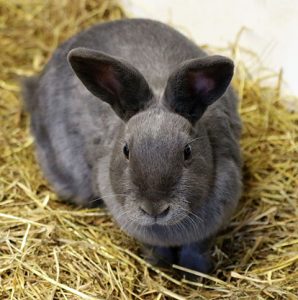In a nutshell – yes, they do! Any entire doe (unneutered female rabbit) is at risk – the most common is uterine adenocarcinoma and this is a really nasty, aggressive and malignant disease. 
How common is it, really?
There is very good evidence to suggest that it is the most common tumour of female rabbits – roughly 60% of entire female rabbits aged over 3 years will have a tumour growing in their uterus, and by the time they reach 6 years, this may be as high as 80%. Essentially, the evidence suggests that pretty much every female rabbit will develop uterine cancer if they live long enough.
Why does it happen?
The rabbit is supremely well evolved to reproduce (left in ideal conditions, a single pair of rabbits could theoretically produce 185,000,000,000 descendants in just 7 years!). However, this means that their reproductive tract is having to “work” really hard. This results in “metaplasia” – chronic changes to the uterine wall associated, it seems, with an environment where the hormone levels are fluctuating relatively rapidly. In time, these changes become more and more pronounced until a “neoplasm”, or cancer, forms.
It’s important to note that whether or not a doe has been bred doesn’t seem to impact her cancer risk. In other words, you cannot protect her from developing uterine cancers by breeding from her, or by not breeding from her.
What are the symptoms?
The nasty thing about tumours in general, and uterine tumours in particular is that there often aren’t any symptoms until fairly late in the course of the disease (by which point it is likely that the cancer has spread to other organs). Often, the first sign is an irregularity in the doe’s oestrus cycle (which you’re unlikely to notice unless you’re trying to breed from her). Sometimes, owners mistake this for the menopause – but unlike humans, rabbits don’t get a menopause and any disruption in their reproductive cycle is seriously abnormal!
Later, symptoms may include weight loss (often despite having a healthy appetite), then blood in the urine or bleeding from the vulva.
Once the tumour spreads to other organs, they too may start to fail (for example, causing kidney or liver disease); but most commonly it spreads to the lungs, resulting in coughing, wheezing or breathlessness.
Eventually, the affected rabbit will die, usually from starvation (as the tumour is eating all her food), internal bleeding, or asphyxiation as her lungs fail.
How bad is it?
Pretty bad. These tumours rapidly spread from the uterus to other abdominal organs, and then to the lungs. If untreated, the average survival time is just over 18 months – but this is from the appearance of the tumour, not from the appearance of clinical symptoms, which usually occur at the end of the disease anyway. Once a rabbit starts showing symptoms, death often occurs within a few months without rapid and radical treatment.
How can it be treated?
The only treatment is complete surgical removal of the uterus and ovaries – and this must be done as early as possible, before the tumour spreads to other organs. Sadly, once that has occurred, there is no effective treatment available.
Is there any way to prevent it?
Yes, there is – spay rabbits as soon as possible after puberty. Without a uterus, she cannot develop uterine cancer! However, earlier is definitely better – about one in 25 does has a tumour by 2 years of age and while these probably aren’t causing any symptoms yet, they may already have started to spread. As a result, and also to improve her temperament (and prevent you being flooded with kits!) we’d recommend spaying at 5-6 months of age.
If you want to talk about your rabbit’s health, call and talk to one of our vets!
